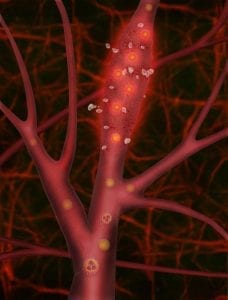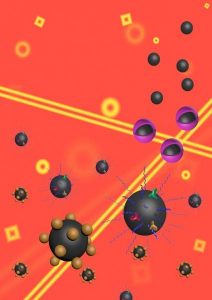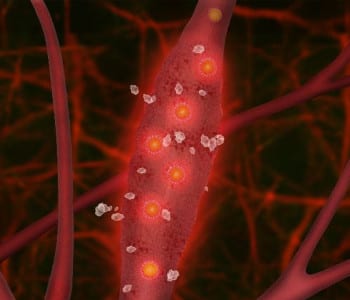By Bin Liu , Xiaohu Gao , and Lanry Lin Yue Yung
In recent years, we have witnessed the fast growing field of particles in healthcare research and industry. When properly designed, micro- and nanoparticles can penetrate tissues and be uptaken by cells, which provide new opportunities in sensing, imaging, and drug delivery. Although much attention has been paid to the synthesis of particles with precisely controlled sizes and shapes and in the understanding of their unique electronic and optical properties, significant achievements have also been made in surface chemistry and functionalization, as particles’ physical stability in complex biological media and surface functional groups have important roles in their overall biological performance. In the Special Issue published in Particle & Particle Systems Characterization in December 2014, the latest advances in micro- and nanoparticle development are highlighted for various biological and biomedical applications, which are expected to further stimulate interests and innovations in healthcare research.
The unique optical and electronic properties of micro- and nanoparticles make them ideal for sensing and imaging applications. A variety of functional particles have been produced on the basis of both inorganic materials (e.g., semiconductor quantum dots, lanthanide up-conversion nanoparticles, metallic nanoparticles, and metal oxides) and organic molecules (e.g., small molecular dyes and conjugated polymers). Fluorescent colloids and plasmonic nanoparticles are of particular interest for sensing and imaging because they are capable of producing intense optical signals for specific analytes once the particle surface is properly modified. These particles have not only facilitated analyte detection in solution, but they also offer exciting opportunities for direct and noninvasive visualization of biological processes in living systems.
 In biomedical applications, remarkable progress has been made in cancer nanotechnology, which has the potential to change the foundation of cancer diagnosis, prognosis, and treatment. Owing to the small size of particles and the leaky vasculature of tumors, formulation of conventional small-molecule drugs and novel biologics (e.g., DNA, small interfering RNAs (siRNAs), and protein) into compact particles has shown great potential in delivering these therapies to tumors while minimizing side effects. Efficient delivery and effective treatment efficacy can be further enhanced by targeting, linking particles with ligands that are specific to tumor cell-surface biomarkers and/or tumor microenvironment. Precise engineering of particle surfaces has been realized using various capping agents and bio-orthogonal coupling reactions.
In biomedical applications, remarkable progress has been made in cancer nanotechnology, which has the potential to change the foundation of cancer diagnosis, prognosis, and treatment. Owing to the small size of particles and the leaky vasculature of tumors, formulation of conventional small-molecule drugs and novel biologics (e.g., DNA, small interfering RNAs (siRNAs), and protein) into compact particles has shown great potential in delivering these therapies to tumors while minimizing side effects. Efficient delivery and effective treatment efficacy can be further enhanced by targeting, linking particles with ligands that are specific to tumor cell-surface biomarkers and/or tumor microenvironment. Precise engineering of particle surfaces has been realized using various capping agents and bio-orthogonal coupling reactions.
The special issue starts with a Review by X. Y. Shi and M. W. Shen on hydrothermal synthesis and functionalization of iron oxide nanoparticles for magnetic resonance imaging. This is followed by a Progress Report (Z. Gu. et. al) on advancing anticancer protein delivery using micro- and nanoparticles. The single Communication in this issue highlights collaborative efforts between B. Z. Tang and B. Liu on the development of chemiluminescent nanoparticles with unique aggregation-induced emission characteristics for hydrogen peroxide imaging. The rest of the contributions are Full Papers, reporting recent progresses in nanomaterial design, synthesis, surface functionalization, and their impacts on healthcare applications. The paper by X. H. Gao and his team specifically addresses the key technical aspects of quantum dot probe preparation for biological assays. The contributions by the groups of L. Y. L Yung, K. L. Yang and X. D. Su relate to biosensing using metallic nanoparticles, taking advantage of their assembly and surface plasmon/fluorescence coupling. The application of graphene oxide in image-guided therapy is demonstrated by P. C. Ray, revealing the potential of carbon-based nanomaterials in healthcare applications. The remaining four papers discuss the effects of nanomaterial surface functionalization on their biomedical applications. A. Tsourka’s team shows that gold nanoparticles labelled with collagenase exhibit improved tumor accumulation in a murine xenograft model; W. W Zhong and co-workers find that albumin coating on single-wall nanotubes reduces their cytotoxicity. B. Narasimhan and co-workers report that the nanoparticle chemistry regulates dendritic cell-nanoparticle interactions.
It is exciting that the field of particles for healthcare has expanded significantly in recent years. Despite great advances in particle physics and chemical synthesis, design and engineering nanomaterials that simultaneously achieve functionality and biocompatibility remain challenging, as the long-term safety and clearance of many current “prototype” particles are largely unknown at this time. For future clinical translation, it will require synergistic efforts from scientists and engineers across the fields of chemistry, physics, engineering, biology, medicine, and healthcare industry. We thus hope this timely special issue will bring together such efforts to further advance the field of particles for healthcare applications. We are grateful to all the contributors and reviewers for their dedicated work and the editorial team at Wiley-VCH for their strong support.
for healthcare has expanded significantly in recent years. Despite great advances in particle physics and chemical synthesis, design and engineering nanomaterials that simultaneously achieve functionality and biocompatibility remain challenging, as the long-term safety and clearance of many current “prototype” particles are largely unknown at this time. For future clinical translation, it will require synergistic efforts from scientists and engineers across the fields of chemistry, physics, engineering, biology, medicine, and healthcare industry. We thus hope this timely special issue will bring together such efforts to further advance the field of particles for healthcare applications. We are grateful to all the contributors and reviewers for their dedicated work and the editorial team at Wiley-VCH for their strong support.
 Dr. Bin Liu received her Ph.D. degree from the National University of Singapore (NUS) before her postdoctoral training at the University of California, Santa Barbara. She joined the Chemical and Biomolecular Engineering Department of NUS at the end of 2005. Dr. Liu was promoted to associate professor in 2010 and was named Dean’s Chair Professor in 2014. Her current research focuses on organic nanomaterials for sensing, image-guided therapy and optoelectronic device applications. Dr. Liu’s awards include the National Science and Technology Young Scientist Award 2008, L’Oreal Woman in Science National Fellowship 2011, and National Research Foundation Investigatorship 2014.
Dr. Bin Liu received her Ph.D. degree from the National University of Singapore (NUS) before her postdoctoral training at the University of California, Santa Barbara. She joined the Chemical and Biomolecular Engineering Department of NUS at the end of 2005. Dr. Liu was promoted to associate professor in 2010 and was named Dean’s Chair Professor in 2014. Her current research focuses on organic nanomaterials for sensing, image-guided therapy and optoelectronic device applications. Dr. Liu’s awards include the National Science and Technology Young Scientist Award 2008, L’Oreal Woman in Science National Fellowship 2011, and National Research Foundation Investigatorship 2014.

Dr. Xiaohu Gao is a faculty member in the Department of Bioengineering at the University of Washington. He received his Ph.D. degree in bioanalytical chemistry from Indiana University, Bloomington in 2004, and his postdoctoral training from the Department of Biomedical Engineering at Georgia Tech and Emory University (2004–2005). His research program is focused on biomedical nanotechnology, biomolecular engineering, molecular imaging, and targeted drug delivery. He is a recipient of the NSF CAREER Award and has been a member of the American Chemical Society (ACS) and Biomedical Engineering Society (BMES) since 2003.
Dr. Lin Yue Lanry Yung received his Ph.D. in chemical engineering from the University of Delaware (1998). After working in Menicon Co. in Nagoya, Japan for contact lens development, he joined the Department of Chemical and Biomolecular Engineering at the National University of Singapore as a faculty member (2003-present). His research focuses on bionanotechnology, DNA circuit, molecular diagnostics and environmental engineering. He is a member of the American Chemical Society (ACS) and American Institute of Chemical Engineers (AIChE).


















